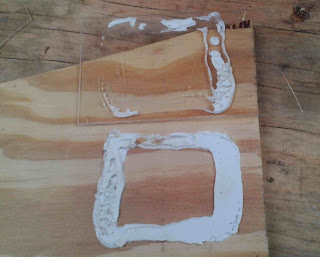I found little splinters trying to rise up and push up little bubbles under the cloth, so I started wetting the plywood, rubbing a cloth over it against the grain to grab the splinters and lift them, then sanding again to cut them off.
I wetted the whole thing down with water and spread the titebond III, then spread it around with what we used to call a "weenie-roller" in my days on the paint crew.
Now, this business of wetting down with water seemed rather foolish to me at first. I have imported the passage from Dave Zeiger's blog.
Application of Fabric plus Water-Based Pucky
Application consists of the following steps:
- Sweep and wet-tack for a dust-free deck
- Lay out fabric (may be overlapped, but abutting is sufficient and smoother)
- Wet out fabric (Yep. Water... drippy wet)
- Paint on pucky (may thin somewhat with water, if necessary for low-drag)
- Dry
- If not satisfied, repeat from 3 (a bit of weave left provides texture)
- Prime and top-coat
The first round of 1-4 is the primary adhesion step. As the water dries out of the weave, waterbourne pucky wicks (is drawn by capillary action) down into pores of the plywood substrate, creating a permeating bond interface. Subsequent layers build to coat and fill the weave.
On a warm, dry day, water evaporates quickly. If the fabric is drying ahead of you, consider keeping a water-brush on hand to refresh the wet. Without that water, wicking is reduced, and glue may not dilute and penetrate the fabric or wood surfaces for full adhesion.
At the end of the first pass, the fabric is only lightly bonded, however, and can be fairly easily torn away. It is reenforced by subsequent passes, however, and the result is firmly attached.
Consider whether to leave some weave for texture (thin matrix), or fill past the top of the weave for longevity (thick matrix). In the latter case, you might consider added texture in the topcoat.
My only semi-eddicated opinion is that green (not completely cured) layers bond better. Thus many layers can be applied in a single day. I especially like to prime over a green layer, in effect gluing the primer to the matrix. The whole seems to cure well over ensuing days (possibly even faster than the generally indicated 24 to 48 hours).
I mean, how can wet wood bond better to glue than dry wood? If there were some great adhesion advantage, wouldn't they tell you to wet the wood whenever you tried to glue it?
Regardless, I found the wetting to really help in positioning the cloth and make everything go smoothly. I can't imagine trying to do it on a hot day with everything dry.
 |
| rolly-rolly la la la |
 |
| aft deck done |
 |
| Fore deck done |
 |
| Starboard coach roof done |










